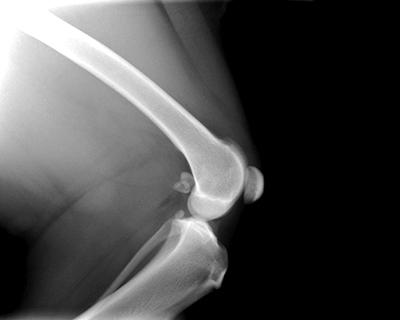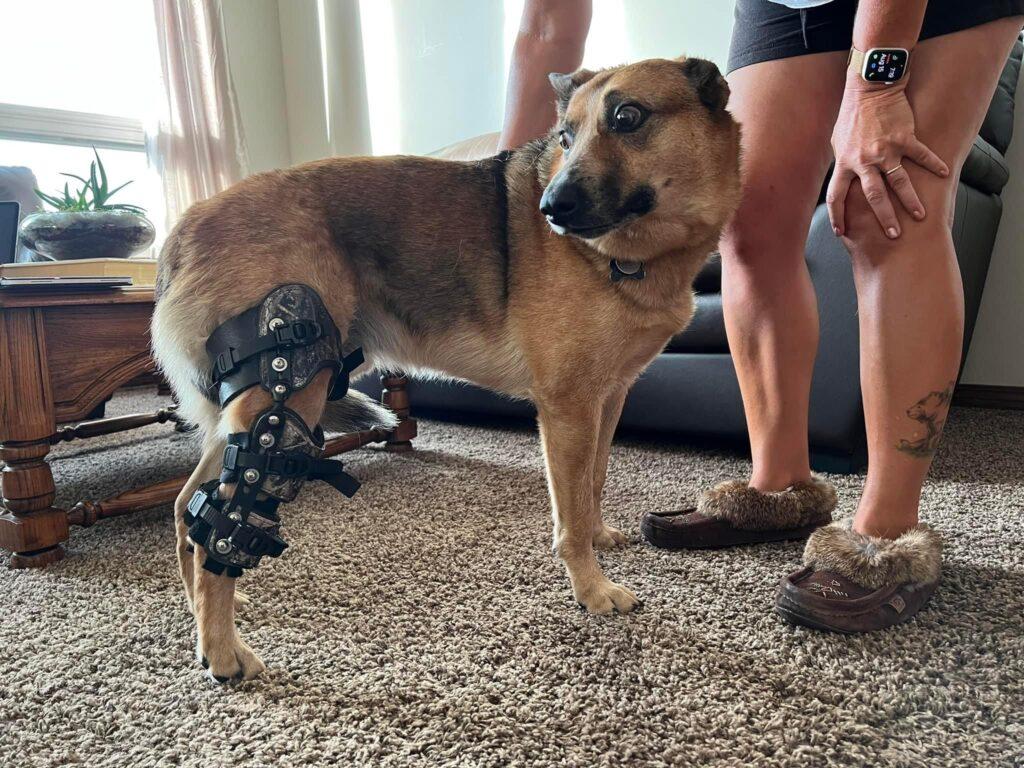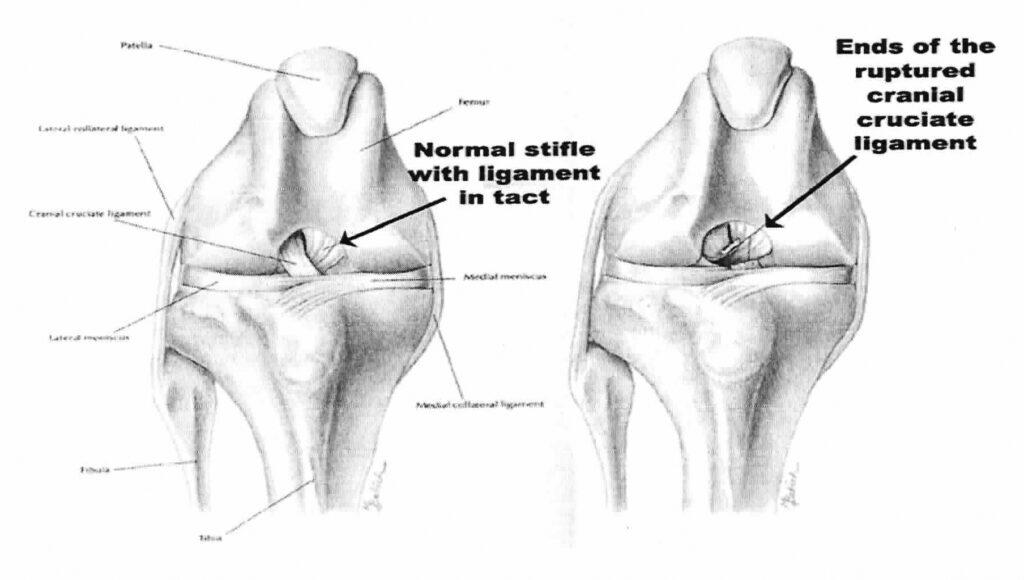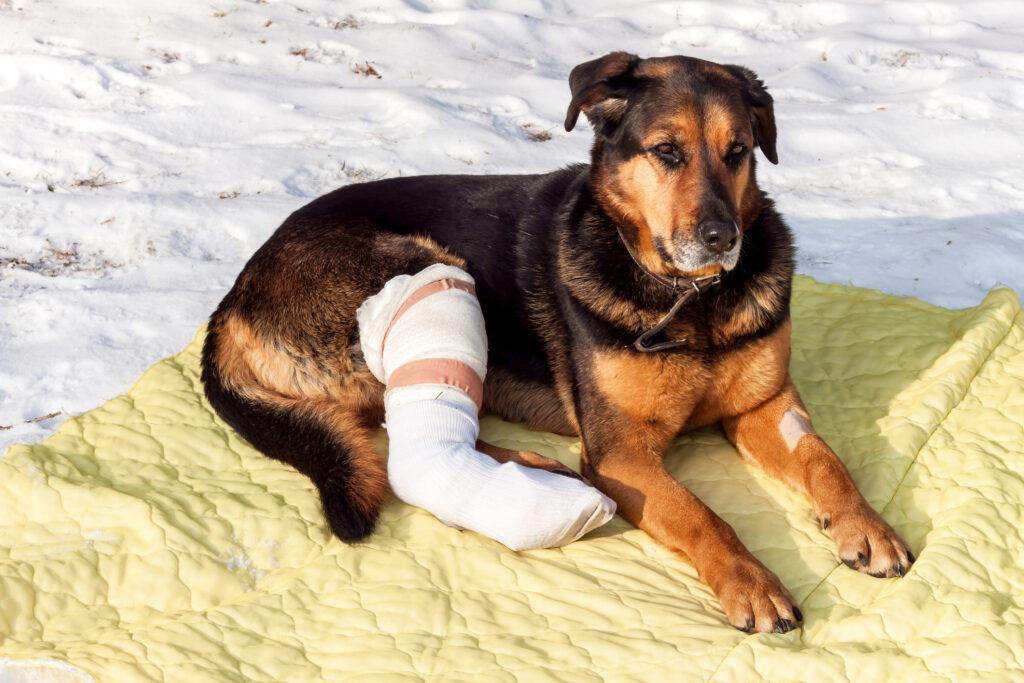Hey guys, this is Nikki lead Veterinary Technician with Posh Dog Knee Braces. Let’s talk about the cruciate ligament, and what it does for us. As the name states, the cruciate ligaments form a cross behind the dog’s knee. The Cranial Cruciate Ligament in dogs is the same as the anterior cruciate ligament (ACL) in humans. This is made up of many different fibers that work to attach the femur to the tibia, which keeps the tibia from moving.
This is why in order to diagnose a CCL rupture, your veterinarian will do what is called a “drawer test” in which they check the movement and shifting of the tibia. If the ligaments are healthy, there should be no movement, or positive drawer sign.

Trauma or degenerative disease to the ligament can damage some of the fibers that make up this ligament. Sometimes you may be told it is a “partial” or a “full” cruciate ligaments tear, however, this is impossible to fully know without going into the joint arthroscopically, or having an MRI done.
We can’t know if the ligaments are simply diseased and stretching more than they should, or fully ruptured which then puts strain on the meniscus. With a trauma, these fibers tear all at once, causing pain and inflammation, and more acute symptoms. Degenerative disease is like a fraying rope, those fibers break over time, and you may not notice the subtle signs. Or your dog may limp here or there, but not all the time.
Unfortunately, most ruptures in a dog are the result of long-term degeneration, where things get weaker and tear over a period of time. Genetics are one of the reasons for degeneration, these breeds include Labradors, rottweilers, boxers, west highland terriers, and newfoundlands. There are more breeds, but these are the most common. Some family lines can be checked out, and I would encourage asking about any history on a future puppy in one of these breeds. It can be detrimental to have a healthy 2 or 3 year old dog with bilateral CCL tears, and we do unfortunately see that.
Another factor to think about would be early spay or neuter. I have another blog on this subject if you would like more information, but to summarize we should not be spaying or neutering until a dog has reached maturity. By doing so, we cause the tibia to continue to grow, which can change the angle in the knee stretching the ligaments. At least a year as a minimum, some large breeds should be 2 years before sterilizing.
Fraying of the ligament can trigger a lot of internal things, such as pain and lameness. Usually with degeneration, there is already osteoarthritis present. The goal here is to stop the movement of the knee, either with a surgical procedure or the less invasive knee bracing options. Bracing will stop the movement of the tibial thrust, as well as acting as a shock absorber, allowing a patient to fully weight bear with the brace on. This will help with getting back to walks and a happy lifestyle.
The more osteoarthritis present, the less successful a patient will be with surgery. As the majority of cases are degenerative, bracing seems to be one of the better solutions. Please email us with any questions, and check us out on Facebook. Let’s help improve his life and yours with our Posh Dog Knee Brace. Custom Crafted Dog Knee Brace, is much more effective than a ready to wear or a soft dog ACL/CCL brace. You can contact Posh Dog Knee Brace via phone at 509-412-3065.
Today I would like to talk about recommended activity levels with a brace or CCL tear. It is still important to remember that this is not a race. Recovery from a CCL takes time, which is why we use a gradual increase in activities.

Initially, we start with walks and light physical therapy and massage. Gradually, we can increase activities, such as adding hills or inclines to the walk, sit stands, more muscle building activities.
It is not recommended to let your dog run off leash while in recovery. This can lead to injury of the other leg potentially. Braced walks are meant to be nice and slow, not a jog. The goal is to have your dog placing full weight down on his leg. If you walk or run too fast, they will skip and not place full weight on the leg.
We will get to a point where your pup can play off leash, but ask first, and take things slow. Feel free to email or send in a contact request with any questions, we are happy to help!
Give Your Dog a Big Hug From Us!
Nikki, Posh Lead Veterinary Technician
Looking for more information about our Posh Dog Knee Brace contact us via our contact form or visit our Facebook Page.
Hey guys, this is Nikki Lead Veterinary Technician with Posh Dog Knee Braces. Today, let’s talk about Cranial Cruciate Ligament Repair (CCL/ACL) tears in a dog, and what your options are. First of all, if your dog is limping on the hind leg, be sure to get a diagnosis from your veterinarian before making any decisions. Once that takes place, be firm with your Veterinarian if needed and ask for the exact diagnosis. If they feel that your dog has a Cranial Cruciate Ligament tear, or CCL tear, then you do have some decisions to make moving forward. Let’s go into the options, and the pros and cons, as well as long term expectations.
First off, depending on your veterinarian, they may refer you to a specialist to verify the diagnosis. This is completely up to you, but do know that if you go to a specialist, they are typically surgeons, and will not be happy without scheduling your dog for surgery. Please know that you can say no. I can’t stress enough how important it is for you to take a breath, and go over all options before signing that dotted line.

Choosing to do just conservative management, with no support or surgery. This seems to be gaining momentum and popularity, because obviously options can cost money. There are supportive things to do, such as keeping your dog in a kennel, leash walks outside, supplements, acupuncture, laser, prp, ect. While this option is better for the budget, it is not for the busy owner, or owners with small children and other pets. While it sounds great, reality is that there is a great chance your pup will continue to re-injure their knee. At some point, the door will open, and your dog will want to run.
Someone will forget, your dog looks like he is dong better at 3 months, and in he comes with the leg hiked all the way up to the groin. Sound familiar? This can be a tough cycle, and the bones in the knee are still able to move, causing pressure on the meniscus as well increasing your dog’s chance of arthritis down the road. So, can a knee heal with conservative management alone? Possibly, but there could be long term issues if you do not do passive range of motion, PT, and exercising along with CM alone.
This is by far my favorite option, from years of experience working with orthopedics. Using an orthotic Brace in conjunction with PROM and PT, as well as supplements and support. Now I am not talking about the cheap over the counter neoprene braces that have a spiderweb of straps connecting to the harness or back, those are no better than just letting the knee recover alone.
I am talking about a custom made premium orthotic brace, such as the Posh Dog Knee Brace. Posh Brace fully stabilizes the knee, allowing for range of motion and squatting, while also acting as a shock absorber for the meniscus. This is going to help give a smoother recovery, and allow that scar tissue to form without a lot of re-injuries. Thus, this is one of the safer options, and definitely still less than surgery.
Tightrope, lateral suture, or extracapsular repair. This is the cheapest of the surgical options, and should only be used on patients under 30-40lbs, as the suture has double the chance of failing in larger breed patients. This method usually is in the $2k-$3k ballpark range now, and is literally using fishing line/or suture to wrap around the knee joint to keep things in place. There are several ways this can and usually does fail. The crimps can come off, the suture can break, the suture can slip, ect.
These patients are immobile for months, and do get a lot of atrophy in the joint. This seems to be sore to recover from, and without a brace post op, your dog is going to need to be kenneled for weeks to months, to allow for scar tissue to properly form. This technique is similar to if you braced, however, without the full stabilization and support, and double the cost.
TPLO or TTA surgery. Both of these will be suggested by your vet or surgeon, usually first. They both entail cutting of the tibia bone, and re-alignment using a plate and screws. This is permanent, and there is no going back if something doesn’t go the way it was meant to. I always save this for my last option, as it is extremely invasive, expensive, and does not give a guarantee of working. Too many patients have had lifelong lameness due to choosing this option, and are not able to recover fully.
There are many weeks needed for kenneling, so the leg will atrophy. This also causes overcompensating on the good knee, which again increases the chances of another CCL tear in that leg. If surgery does go well, and you are able to do a full Physical Therapy Program post op with a professional, your dog may have a good outcome, but this is not without risk.
Please email me at poshintake1@gmail.com if you would like to ask more questions about Cranial Cruciate Ligament Repair, CCL/ACL tears in dogs, and what the best options are for your pup. You can also contact via our forms or visit our Facebook page.
We’ve been following Dr. Will Falconer DVM, for over 6 years. His site Vital Animal is a very rare resource for any Pet parent who wishes to learn how to achieve the healthiest and extended life for their Fur child.
We call Dr. Will a bona fide: hero. He tells the truth about REAL Veterinary care and about cruciate injuries causes and treatments.
Learn the heath care tips which your allopathic vet may not know, or may not have told you, by subscribing (free) to Dr. Wills newsletter. Dr. Will has deveoped an array of hugely beneficial, free, and also some inexpensive courses, all of which are very relevant REAL health care tips that we feel any Pet parent needs to investigate. His mission is unequivocally: to allow you and your beloved Dog or Cat to share as many years of unrequited love together as possible.

The extraordinary info he has shared with us through the years has saved us several thousands dollars, and a lot of worry, in learning how to truly care for our beloved Dogs and about cruciate injuries causes and treatments.
This Animal Hero has been a Veterinarian for almost 40 years, with 25 years of Homeopathic care. To quote Dr. Will:
I’ve learned that prevention is indeed important, but not done in the usual way promulgated by conventional medicine. You’ll do well to be very, very cautious about what’s offered under that banner in conventional veterinary practices across the globe. It’s a clear case of caveat emptor: Let the buyer beware.
In an increasingly turbulent and treacherous sea of [dangerous] “allopathic” medicine, see how Dr. Will can be your safe haven, a veritable life raft, for you and your Dog. Dr. Will personifies the quintessence of the word: Doctor.
Even if you never get a Posh Brace, you must check this exceptional and iconoclastic DVM out.
Dr. Will, thank you for your decades of unbridled dedication to helping our Animal children live a long and healthy life!
If you are interested in purchasing or brace visit our Store. Or if you need more information about cruciate injuries causes and treatments please contact us anytime.
Read reviews check out our Google Reviews online. Click Here